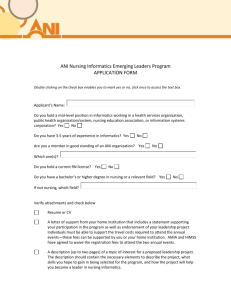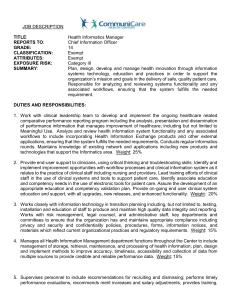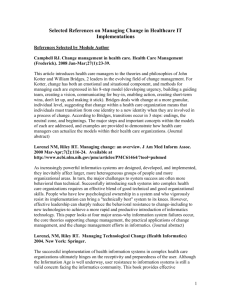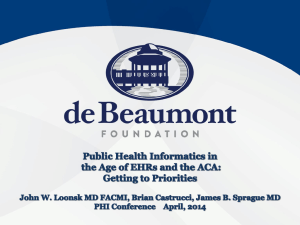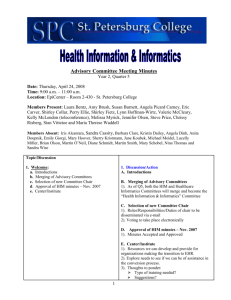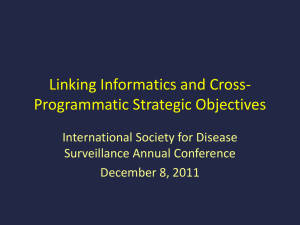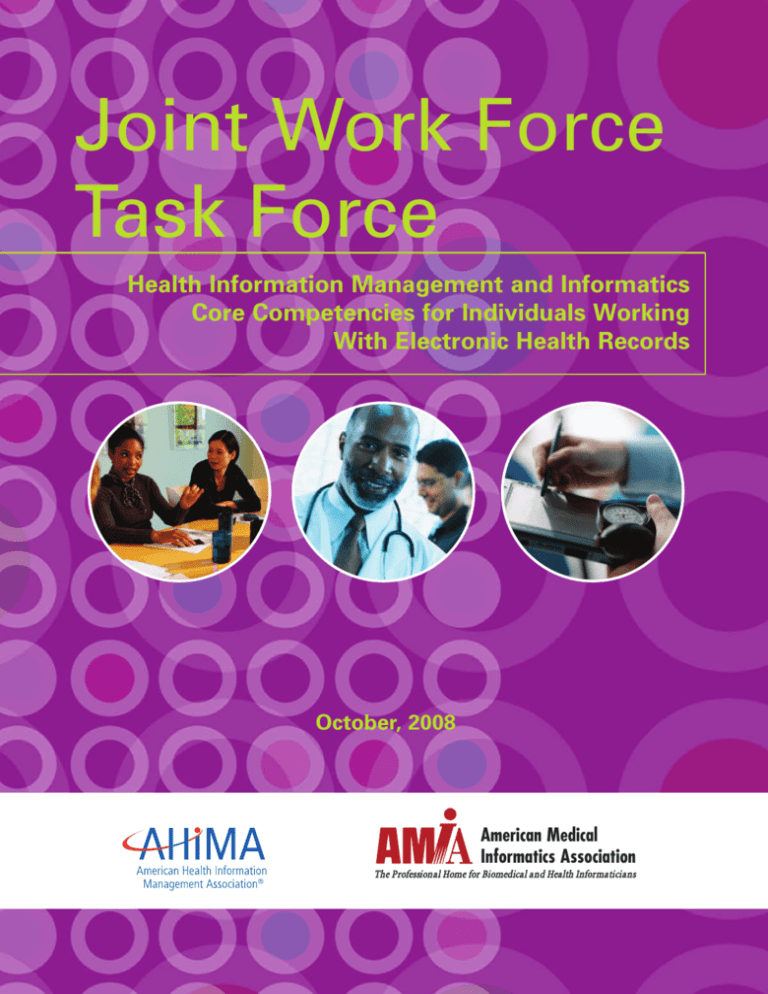
Joint Work Force
Task Force
Health Information Management and Informatics
Core Competencies for Individuals Working
With Electronic Health Records
October, 2008
American Medical
Informatics Association
Th e P rofessi on a l Home for Bi omedica l a n d Hea lth Infor ma ti ci a ns
Acknowledgements
Acknowledgements
Contents
AMIA and AHIMA would like to thank the following individuals who participated in
this project as Task Force Members:
Executive Summary
Participants
Staff
Background
Teresa Foley, MA, RHIA, CPHC
Medical Record Consultant Office of the
Surgeon General
Meryl Bloomrosen, MBA
Vice President, AMIA
Recommendations
to the Industry
A Work Force
Action Agenda
Conclusion
References
Elizabeth Franchi, RHIA
Data Quality Coordinator, VHA
Carole A. Gassert, RN, PhD, FACMI, FAAN,
University of Utah College of Nursing
Associate Dean, Information and Technology
Kim Harris-Salamone, PhD, Director,
Physician Office Quality Health Services
Advisory Group, Inc.
Judith Logan, MD, MS
Associate Professor in the Department of
Medical Informatics and Clinical
Epidemiology
Sandi Mitchell, RPh, MSIS
Director Pharmacy Informatics Residency
Program Medication Use Information,
Department of Pharmacy
Bonnie Petterson, PhD, RHIA
Health Information Technology Program
Director – Phoenix College
Copyright ©2008 by the American
Medical Informatics Association
(AMIA). All rights reserved. No part
of this publication may be
reproduced, reprinted, stored in a
retrieval system, or transmitted n any
form or by any means, electronic,
photocopying, recording, or
otherwise without the prior written
permission of the Association.
Mikia Heard, RHIA
HIM Intern
Tania Kuhl, BS
HIM Intern
Claire Dixon-Lee, PhD, RHIA, FAHIMA
Vice President, AHIMA
Linde Tesch, RHIA
AHIMA Staff
Nania Walia, BS
HIM Intern
Preface
Health Information
Management and Informatics
Core Competencies for
Individuals Working With
Electronic Health Records
One of the recommendations from the 2005 work force
summit and contained in the 2006 report was to:
Convene a joint task force to define basic competencies
for those who use EHRs in their daily work. In order to
carry out that recommendation, the associations created a
joint work force task group. The work force task group
convened during 2007-2008 and completed its work with
the issuance of this report.
Background
In 2005, the American Medical Informatics
Association (AMIA) and the American Health
Information Management Association (AHIMA) created
a process and a committee to jointly develop and address
a common public policy agenda. One of the first action
items on the joint committee’s agenda was to address the
urgent need to support investments in education and
training for health informatics and health information
management (HIM) professionals. Recognizing the
demands of an increasingly global and electronic
healthcare environment, AMIA and AHIMA hosted a
work force summit meeting in November 2005 and in
2006 issued a report entitled, “Building the Work Force for
Health Information Transformation” (see
www.amia.org/inside/initiatives/workforce.asp).
Workforce issues are major priorities for both AMIA
and AHIMA. In addition to this task force, the
associations are engaged in a number of activities to
help support the preparation, growth and development
of a work force in an increasingly electronic health
environment. These activities are briefly described in
the Appendix (D) to this report.
3
Introduction
Introduction
The American Health Information Management
Association (AHIMA) and the American Medical
Informatics Association (AMIA) are committed to the
development of a healthcare system that uses best evidence
to support the health and healthcare services for
individuals and populations. This will occur within a
slowly emerging nationwide health information system.
The organizations’ leaders believe that additional
education and training is needed for the health workforce
to play a critical role in the transformation of the
American healthcare system.
The growing role of information technology within
healthcare delivery organizations has created the need to
deepen and widen the pool of workers who can help
organizations maximize the ongoing effectiveness of their
investment in information technology, and in so doing
maximize impact on equity, safety, patient-centeredness,
timeliness, effectiveness and efficiency of care. Globally,
the health industry is engaged in wide-scale
implementation of information systems to support various
national and international imperatives, including
providing clinical care, research and education, public
health reporting and surveillance, homeland security, and
conquering diseases. The health sector faces an expanding
array of sophisticated clinical information systems that are
being implemented into a broader range of settings, thereby
increasing the volume and complexity of data and giving
evidence of the growing role that information systems will
play in virtually every aspect of healthcare delivery.1
The purpose of this document is to introduce a model for
potential use across various health and allied health
disciplines and to guide education and training for
individuals working with EHRs.
Background
AMIA and AHIMA hosted a meeting, the Work Force for
Health Information Transformation: A Strategy Summit in
Washington, DC, in November 2005, which brought
together public and private stakeholders from academia,
business, government, professional associations, and
provider organizations. A formal report was published
titled Building the Work Force for Health Information
Transformation in February 20062 summarizing the
proceedings. The report contained targeted
recommendations to healthcare employers, employees,
industry representatives, government, and professional
organizations for preparing the existing healthcare work
force to use technology tools and to ensure a sufficient
number of well-qualified health information specialists to
achieve effective health IT transformation.
Specific recommendations in the report included:
• Convene a joint task force to define basic competencies
for those who use EHRs in their daily work
• Encourage leadership from employers and health IT
industry representatives for on-the-job training and
support for current healthcare workers
• Create incentives and encourage the healthcare work
force to see health information competencies and skills
as professional and personal goals
• Seek federal support for health IT adoption, training,
and legislation to increase funding for education
programs and students
• Incorporate health informatics education requirements
for all health professions.
4
1 AMIA's White Paper Policy Series on Timely Issues in Informatics, Don E.
Detmer and Charles Safran, Journal of the American Medical Informatics
Association. 2005, 12(4):495.
2 AHIMA, AMIA, Building the Work Force for Health Information
Transformation, February 2006.
Workforce Task Force
Workforce Task Force
In 2007, AHIMA and AMIA convened a Joint Workforce
Task Force (WF-TF) to address one of the
recommendations: the need for basic core competencies
expected of a healthcare workforce that uses EHRs in their
daily work in the era of electronic health information
technology. AMIA and AHIMA each identified members
with background, experience, and expertise in training,
curriculum design, health information management;
health informatics and workforce development.
There are several important cross-cutting issues, including
the wide variety of health professionals—from physicians
and nurses to therapists and admissions staff—who are or
will be using EHRs as part of their day-to-day activities.
This, in turn, has an impact on the broad range of training
needed, from basic computer literacy to more
sophisticated computer applications and health
information management skills; the range of environments
in which training will take place, from professional
education programs to the workplace itself; and the
important role of vendors in the training process.3
Intended Audiences
It is vital that private and public policymakers know that
core competencies are fundamental to educate and train
current and additional workforce members. Through
them, the nation can achieve its health information
technology and data use goals. The intended audience for
these core competencies is widespread and comprises the
foundation for training as well as formal education of any
health worker creating, accessing or using EHRs in their
daily work. This includes various professional associations
representing healthcare disciplines, healthcare employers
who are targeting training for non-professional healthcare
workers who use electronic health information systems in
their daily work, and for college and university faculty in
updating curricula for the clinical, health and allied health
disciplines.
New graduates in any healthcare profession need a skill set
adaptable to computer technologies and EHRs to support
work processes and information access experienced in the
course of daily workflow. Employees at all levels and job
types within today’s healthcare workplace need a new set
of skills and knowledge to embrace and effectively utilize
computer technologies and electronic information. Part of
the challenge is ensuring these workers function in a broad
continuum of care and effective use of health information
and electronic information systems. In addition, it is
anticipated that these workers are likely to have different
responsibilities due to the use and application of electronic
health records.
3 Center for Health Workforce Studies. 2005. The role of innovative
technologies in improving the quality of patient care: Training
implications for the health workforce. http://chws.albany.edu
5
Purpose
Purpose
The EHR core competencies matrix tool is offered for use
by various educational and training programs, healthcare
organizations and professions. We envision several
specific purposes, including: (a) supporting the design of
in-service and on-the-job training programs for the
current workforce who encounter and use the EHR; (b)
serving as a reference for healthcare workforce job
descriptions; (c) planning professional development
activities; (d) building specific professional competencies
(after review and expansion by various health
professions); (e) developing new employee orientation
programs; and (f) improving formal health professional
academic curricula. The matrix tool is a model that
captures the basic core competencies and sorts on those
competencies thought to be applicable to each of varied
roles and settings of healthcare delivery, and the workflow
needs of each.
To encourage development of models for training and
academic education of the EHR core competencies
matrix tool, government policymakers are urged to
consider funding programs to disseminate this
fundamental information.
These competencies can be used by healthcare employers
and other relevant organizations as part of ongoing
orientation and training programs for healthcare workers
who use the EHR and health information in their daily
work. Health professions and their professional
organizations can adopt and incorporate applicable basic
competencies in professional development and training
activities for the current work force as well as including
them in academic curricula. For example, the core
competencies can be applied in multiple ways to help
train a workforce in appropriate use of an EHR; access to
health information in a health data network or health
information exchange, basic knowledge for those who
implement and install an EHR, or actively participate in
such a process.
6
Appendix A includes proposed core competencies in five
domains or categories:
I.
II.
III.
IV.
V.
Health information literacy and skills
Health informatics skills using the EHR
Privacy and confidentiality of health information
Health information/data technical security
Basic computer literacy skills.
Several roles represent the broad range of healthcare
workers and work settings, including physicians, nurses,
ancillary care providers (allied health), pharmacists,
information technologist (IT), administrative personnel,
clerical staff, human resources, financial/regulatory, third
party payors, data analysts/providers, public health
workers, consumer/patient/family, therapists (such as
physical, occupational, respiratory), health information
exchange staff (HIE), emergency medical personnel,
medical assistants, clerical (such as admissions clerks,
healthcare access manager), dietary workers, transport
services, physician extenders (such as physician assistants
and nurse practitioners) laboratory or radiology
technicians; reception/volunteer desk; and nurses’ aides.
Work settings are characterized as: acute care, ambulatory
care, physician’s office, ancillary entities, outpatient
clinics, military hospital, pharmacy, vendors (EHR/PHR),
public health agencies, regional health information
exchanges, health record banks, health information service
providers, long-term care facilities, behavioral health,
rehabilitation centers, independent diagnostic facilities,
community-based healthcare organizations, specialty care
services, hospice, employers/occupational health, dental
clinics, psychology services, school/student health services.
Next Steps
To emphasize the type of learning outcome expected of
each competency statement, Bloom’s Taxonomy4 was used
to classify the competency under one or more categories:
(1) cognitive knowledge, (2) affective behavior or attitude,
or (3) psychomotor skill. Bloom’s Taxonomy is used
extensively in higher education, as a standard
classification system that describes the types and level of
learner outcomes resulting from a training process. Use of
Bloom’s Taxonomy helps to specify learning competencies
so that after a training or formal education sessions, the
learner should have acquired new knowledge, attitudes
and/or skills. The Workforce Task Force felt that this
would help users of the core competencies matrix tool to
better plan learning experiences and prepare evaluation
methods.
4. Bloom, B.S. (1956). Taxonomy of Educational Objectives. Handbook I:
The Cognitive Domain. New York: David McKay Co. Inc.
Next Steps
Recognizing the growing importance of workforce
development and the continuing shortage of trained
workers within the healthcare system, AHIMA and AMIA
expect to convene a national consensus conference in
second quarter 2009: A Call to Action for Building the
Workforce for Health System Transformation. This
conference would make a defined case for national policy
and funding, specifically targeting attention to the health
information management (HIM) and health IT workforce
needs; assess progress and barriers to meeting HIM/HIT
workforce projections; introduce the EHR Core
Competencies Matrix Tool; and produce
recommendations for further action by stakeholders.
Potential stakeholders would include representatives from
employer organizations, labor unions, professional
associations, HIT vendors, state departments of labor, and
higher education, among others.
7
Appendix A
Appendix A: Workforce Task
Force Framework of Electronic
Health Record (EHR) Core
Competency Statements
To view the EHR Core Competencies Matrix Tool visit:
www.ahima.org or www.amia.org
I. Health information literacy and skills
II. Health informatics skills using the EHR
III. Privacy and confidentiality of health information
IV. Health information/data technical security
V. Basic computer literacy skills.
Within the Core Competencies Matrix Tool cells we list the
skill sets and/or knowledge needed in terms of a
competency statement (attached to a role) and using
Bloom’s Taxonomy structure: cognitive (C), affective (A),
psychomotor (P) indicating the type of learning outcome.
A core competency may impact more than one taxonomy
category for the learner. Below is the complete list of all
core competencies identified by the task group, but only
selected core competencies are applicable to each health care
worker role by using the Core Competencies Matrix Tool.
The health worker should be able to meet the
following competencies as applicable to his/her role,
setting and workflow:
8
Domain I. Health information
literacy and skills
1. Differentiate data versus information.
2. Describe the principles of structure, design, and use of
health information (such as individual, comparative
reports, and trended data).
3. Use health record data collection tools (such as input
screens, document templates).
4. Apply standard data definitions, vocabularies, terminologies, and/or relevant healthcare data sets (such as
OASIS, HEDIS, UHDDS) as used in the organization’s
health information systems.
5. Differentiate between the types and content of patient
health records (such as paper-based, electronic health
records, and personal health records).
6. Adhere to health record documentation requirements of
external agencies and organizations (such as those
specified by the Joint Commission, regulatory bodies,
professional review organizations, licensure, reimbursement, discipline-specific “good practice”).
7. Adhere to internal organizational health record documentation requirements, policies, and procedures.
8. Ensure that documentation in the health record reflects
timeliness, completeness, accuracy, appropriateness,
quality, integrity, and authenticity as required.
9. Adhere to information systems policies and procedures
as required by national health information initiatives
from national, state, local, and organizational levels.
10. Write or update policies and procedures related to
health data and information in daily work.
11. Identify incorrect data and take corrective action.
12. Identify methods and types of data collected in
health care.
13. Maintain professional standards in all documentation
activities.
Appendix A
Domain II. Health informatics skills
using the EHR and PHR
1. Create and update documents within the electronic
health record (EHR) and the personal health record
(PHR).
2. Locate and retrieve information in the electronic health
record for various purposes.
3. Perform data entry of narrative information.
4. Locate and retrieve information from a variety of electronic sources.
5. Differentiate between primary and secondary health
data sources and databases.
6. Know the architecture and data standards of health
information systems.
7. Identify classification and systematic health-related terminologies for coding and information retrieval.
8. Know the policies and procedures related to populating
and using the health data content within primary and
secondary health data sources and databases.
9. Apply appropriate documentation management principles to ensure data quality and integrity.
10. Use software applications to generate reports.
11. Know and apply appropriate methods to ensure the
authenticity of health data entries in electronic
information systems.
12. Use electronic tools and applications for
scheduling patients.
Domain III. Privacy and confidentiality of health information skills
1. Explain legal responsibility, limitations, and implications of actions.
2. Apply the fundamentals of privacy and confidentiality
policies and procedures.
3. Follow legal aspects and regulations of documentation
in requests for information.
4. Identify legal and regulatory requirements related to
the use of personal health information.
5. Identify and apply policies and procedures for access
and disclosure of personal health information.
6. Identify policies and procedures regarding release of
any patient-specific data to authorized users.
7. Identify what constitutes authorized use of personal
health data.
8. Participate in privacy and confidentiality training
programs.
9. Follow security and privacy policies and procedures to
the use of networks, including intranet and Internet.
10. Follow confidentiality and security measures to protect
electronic health information.
11. Maintain data integrity and validity within an
information system.
12. Report any possible breaches of confidentiality in
accordance with organizational policies.
13. Describe the possible consequences of inappropriate
use of health data in terms of disciplinary action.
14. Describe monetary and prison penalties for breaches.
15. Document profession-specific information in an
electronic health record.
16. Know appropriate methods to correct inaccurate
information/errors personally entered in an electronic
health record.
17. Authenticate information entered in an electronic
health record.
18. Access reference material available through an
electronic health record.
19. Identify the source of information entered in an
electronic health record.
20. Identify, evaluate, select, and appropriately use
computer systems for patient information
documentation.
21. Teach others health record concepts, laws,
documentation requirements and organizational
policies and procedures as it applies to your work.
9
Appendix A
Domain IV. Health information/data
technical security skills
1. Implement administrative, physical, and technical
safeguards.
2. Develop security policies and procedures.
3. Resolve minor technology problems associated with
using an electronic health record.
4. Follow access protocols for entry to an electronic
health record.
5. Enforce access and security measures to protect
electronic health information.
6. Recommend elements that must be included in the
design of audit trials and data quality monitoring
programs.
7. Implement policies, procedures, and training for health
data security.
8. Apply departmental and organizational data and
information system security policies.
Domain V. Basic computer
literacy skills
1. Apply basic computer concepts and terminology in
order to use computers and peripheral devices, computer communications systems, general purpose and
organization-specific system applications, and patient
care/health-related software applications.
2. Demonstrate use of the essential aspects of file organization, information storage (such as disk or flash
drive), protection from data loss, and basic computer
skills.
3. Use basic word processing, spreadsheet, database, and
desktop presentation applications as applicable to your
work.
4. Identify, evaluate, and use Web-based literature
resources, CD-ROMs, and Internet resources.
5. Conduct basic file organization and management for
routine storage and protection from data loss.
6. Use statistical analysis packages.
7. Use portable computing devices to facilitate data input
and management.
10
8. Demonstrate basic computer operating procedures
such as login the computer and logoff, opening, closure
and saving files.
9. Demonstrate proficiency in the Windows operating
environment.
10. Resolve minor technical problems associated with use
of computers.
11. Demonstrate Internet/intranet communication skills.
12. Access and use a Web browsing application.
13. Demonstrate use of email, addressing, forwarding,
attachments, and netiquette.
14. Identify and use icons, windows, and menus.
15. Create and name or rename subdirectories and
folders.
16. Open and work with more than one application at
a time.
17. Demonstrate how to save work to a computer file,
and printing and copy a file.
18. Create and edit a formatted document using
tables and graphs.
Appendix B
Appendix B: SAMPLE EHR Core Competencies Matrix Tool by Discipline
(complete matrix tool is available at: www.amia.org and www.ahima.org )
11
Appendix C
Appendix C: List of Allied Health
Professionals and Associations
Dental Hygienist
American Dental Hygienists' Association
(Note: Given the limitations of this project this is not an
exhaustive list of health professions and not all health disciplines’ websites were reviewed.)
Dental Laboratory Technician
National Association of Dental Laboratories
Anesthesiologist Assistant
American Academy of Anesthesiologist Assistants
Art Therapist
American Art Therapy Association
Athletic Trainer
National Athletic Trainers' Association
Audiologist
American Speech-Language-Hearing Association
Blindness and Visual Impairment Professions
Association for Education and Rehabilitation of the Blind
and Visually Impaired
Diagnostic Medical Sonographer
Society of Diagnostic Medical Sonographers
Dietetic Technician, Dietician
American Dietetic Association
Electroneurodiagnostic Technology
American Society of Electroneurodiagnostic Technologists
Emergency Medical Technician-Paramedic
National Association of Emergency Medical Technicians
Genetic Counselor
National Society of Genetic Counselors
Health Information Management
American Health Information Management Association
Blood Bank Technology, Specialist in
American Association of Blood Banks
Health-System Pharmacists
American Society of Health-System Pharmacists
Cardiovascular Technologist
Society for Vascular Ultrasound
American Society of Echocardiography
Alliance of Cardiovascular Professionals
Society of Invasive Cardiovascular Professionals
Histologic Technician/Histotechnologist
National Society for Histotechnology
Clinical Laboratory Science/ Medical Technology
American Society for Clinical Laboratory Science
American Society for Clinical Pathology
Association of Genetic Technologists
Massage Therapist
American Massage Therapy Association
Counseling-related occupations
American Counseling Association
Cytotechnologist
American Society of Cytopathology
Dance/Movement Therapist
American Dance Therapy Association
Dental Assistant
American Dental Assistants Association
12
Kinesiotherapist
American Kinesiotherapy Association
Medical Assistant
American Association of Medical Assistants
Medical and Health Informatics
American Medical Informatics Association
Medical Librarian
Medical Library Association
Music Therapist
American Music Therapy Association
Nuclear Medicine Technologist
Society of Nuclear Medicine -- Technologist Section
Appendix D
Occupational Therapy
American Occupational Therapy Association
Surgical Technologist
Association of Surgical Technologists
Ophthalmic Dispensing Optician
Opticians Association of America
Therapeutic Recreation Specialist
American Therapeutic Recreation Association
Ophthalmic Laboratory Technician
Optical Laboratories Association
Appendix D: Other AMIA and
AHIMA Workforce Related Activities
Ophthalmic Medical Technician/Technologist
Joint Commission on Allied Health Personnel in
Opthalmology
Orthoptist
American Orthoptic Council
Orthotist and Prosthetic
American Orthotic and Prosthetic Association
Pathologists' assistant
American Association of Pathologists' Assistants
Perfusionist
American Society of Extra-Corporeal Technologists
Pharmacy Technician
American Association of Pharmacy Technicians
Physical Therapist, Physical Therapist Assistant
American Physical Therapy Association
Physician Assistant
American Academy of Physician Assistants
Radiation Therapist, Radiographer
American Society of Radiologic Technologists
Rehabilitation Counselor
National Rehabilitation Counseling Association
Respiratory Therapist, Respiratory Therapy Technician
American Association for Respiratory Care
Speech-Language Pathologist
American Speech-Language-Hearing Association
Surgical Assistant
National Surgical Assistant Association
AMIA Activities
1. AMIA believes that certification of physician clinical
informaticians will support the professional needs of
individuals in this role. AMIA is developing certification
to be coordinated with formal training programs for
clinical informaticians as part of the domain of
biomedical and health informatics. This is being
pursued by seeking a medical specialty to sponsor
informatics to the American Board of Medical
Specialties using materials developed by AMIA.
2. As soon as this initiative shows progress, AMIA will
adapt, if needed, the core content prepared for physician
informaticians for doctoral or master’s prepared (nonMDs) clinicians to purse advanced training in clinical
informatics. We anticipate that this will include
candidates for a Ph.D. in medical informatics, doctor of
nursing practice, doctor of pharmacy, etc.
3. AMIA created the Academic Forum as a membership
unit dedicated to serving the needs of post-baccalaureate
biomedical and health informatics training programs.
The Academic Forum was conceived by recognized
leaders to establish a professional home for academic
informatics. The mission of the AMIA Academic Forum
is to promote the development of biomedical and health
informatics as an academic discipline. The Forum
provides a vehicle for surveying and analyzing activities
in academic units dedicated to biomedical and health
informatics and for recommending best practices related
to education, scholarship, faculty development, and
faculty retention. The Forum provides a locus for
discussion of national research initiatives in informatics
and a round table that facilitates collaboration among
different academic units to further their objectives for
education and research.
13
Appendix D
4. AMIA, working through its Academic Forum, is also
identifying a common set of biomedical and health
informatics competencies for members, current and
prospective member institutions, and the greater health
information technology community. Formal and
comprehensive biomedical and health informatics
competencies will provide a foundation and framework
for the discipline and provide guidance to educators
and educational administrators for the advancement of
new and existing informatics training programs, as well
as for faculty recruitment and development. The scope
of the effort includes the domains of translational
bioinformatics, clinical healthcare and research
informatics, and public health/population informatics.
5. AMIA formed the Academic Strategic Leadership
Council as a body to assure that a leadership base
develops within the academic health sciences. The
essential mission of the Academic Strategic Leadership
Council is to act as a catalyst of change to enable
academic health science institutions to lead the way to
improvements in health and health care through
biomedical/health informatics. This leadership will be
reflected in work force development, research,
demonstration of effectiveness and policy. If
successful, academic health science institutions will
evolve into environments that develop and
demonstrate informatics enabled improvements in
public health, care delivery, biomedical research and
health professions education.
6. Further work is underway to delineate what informatics
content and skills are needed in the education of other
clinicians and information managers. To this end,
AMIA’s Academic Strategic Leadership Council (ASLC)
is beginning an initiative in concert with the
Association of Academic Health Centers (AAHC) and a
few other national educational organizations relating to
health. AHIMA is an invited participant to that
initiative.
7. Additionally, AMIA has actively participated in the
Technology Informatics Guiding Educational Reform
(TIGER) Initiative. The TIGER Initiative aims to
enable practicing nurses and nursing students to fully
engage in the unfolding digital era of healthcare.
(/www.tigersummit.com)
14
8. AMIA’s 10x10 program is teaching basic knowledge and
skills in informatics at the graduate course level (see
http://www.amia.org/10x10)
9. AMIA is conducting public health informatics training
for qualified participants under a cooperative
agreement with the Centers for Disease Control and
Prevention (CDC).
10. An emerging AMIA initiative referred to as “20/20 Bits
and Bytes” will consist of carefully defined and focused
biomedical and health informatics knowledge or skills
sets, tools, and content useful and applicable
worldwide.
AHIMA
1. Creation of the Action Community for e-HIM®
Excellence (ACE), composed of HIM professionals who
are leading, influencing and making a difference in the
healthcare work force. See www.ahima.org
2. The Foundation of Research and Education (FORE)
supports an HIM Faculty Development Stipend
program to assist HIM educators with professional
development funding, offers the FORE Research
Institute in its second year of operation, and supports
educators and practitioners seeking advanced
education or research seed monies. See
http://www.ahima.org/fore/about/
3. FORE supports the design and delivery of the Virtual
Electronic Health Record Laboratory project which
provides web-based, vendor-supported information
management technology applications for student
hands-on practice serving over 125 HIM college
programs at the associate, baccalaureate and graduate
levels to prepare graduates for the electronic work force
challenges.
4. Launch of Courseshare, a new service for HIM
educators as a member benefit giving educators access
to peer-reviewed, downloadable content for use in
academic settings with cutting edge content
contributions from educators and professionals in HIM
and related fields.
5. The Assembly on Education (AOE) Summer Symposium
and Faculty Development Institute annually provides a
forum for educators to share, learn and update their
teaching skills to address work force needs
Selected Resources
6. AHIMA is a sponsor of the Commission on
Accreditation for Health Informatics and Information
Management Education (CAHIIM) which recognizes
through accreditation over 250 academic programs in
health information management and health informatics
at the associate, baccalaureate and graduate levels. See
www.cahiim.org
7. AHIMA offers advanced mastery certifications such as
Certified Healthcare Privacy and Security (CHPS) and
the new Certified in Health Data Analytics credential.
8. Through AHIMA’s Vision 2016 for Quality Education in
HIM, two studies in 2008 focus on educators’ issues and
an employer survey of future roles and competencies of
graduate level HIM professionals. See
http://www.ahima.org/emerging_issues/Vision2016Blue
printforEduc.pdf
9. Work has begun on an International core curriculum
model for HIM in countries embracing EHRs.
10. AHIMA continues to align with AMIA, HIMSS, TIGER
and numerous other initiatives to build and strengthen
the healthcare workforce for the future.
American Journal of Health-System Pharmacy. ASHP
Statement on the Pharmacist's Role in Informatics. ASHP
REPORT 64(2):200-203, January 15, 2007. Developed
through the ASHP Section of Pharmacy Practice Managers
and Approved by the ASHP Board of Directors on March
28, 2006, and by the ASHP House of Delegates on June 27,
2006.
Aronson, Dina MS, RD. High-Tech Counseling: An
Untapped Market for Today’s Dietitian? Today’s Dietitian
March, 2007 Vol. 9 No. 3 P. 46.
Balen RM, Jewesson PJ. Pharmacist computer skills and
needs assessment survey.
J Med Internet Res. 2004 Mar 29;6(1).
Barton AJ. Cultivating informatics competencies in a
community of practice. Nursing Administration Quarterly
2005 Oct-Dec;29(4):323-8. Review.
Selected Resources
Bickford CJ. Informatics competencies for nurse managers
and their staffs.
Semin Nurse Management. 2002 Jun;10(2):110-3. Erratum
in: Semin Nurse Management 2002 Sep;10(3):215.
ACHE, HFMA, MGMA, AONE and ACPE define
competencies for healthcare management.
http://www.healthcareleadershipalliance.org/
Accessed February 12, 2008.
Bloom, B.S. Taxonomy of Educational Objectives,
Handbook I: The Cognitive Domain. New York: David
McKay Co. Inc.; 1956.
Allegrante JP, Moon RW, Auld ME, Gebbie KM.
Continuing-education needs of the currently employed
public health education workforce. American Journal of
Public Health. 2001;91:1230–1234.
Carr DM. A team approach to EHR implementation and
maintenance. Nursing Management. 2004 Oct;35 Suppl
5:15-6.
American Health Information Management Association
(AHIMA)
http://www.ahima.org/certification/competency.ccsp.asp
Center for Health Workforce Studies. 2005. The role of
innovative technologies in improving the quality of patient
care: Training implications for the health workforce.
http://chws.albany.edu
American Hospital Association. 2005. Forward
momentum: Hospital use of information technology.
http://www.ahapolicyforum.org/ahapolicyforum/resources/co
ntent/FINALNonEmbITSurvey105.pdf
Covvey HD, Fenton S, Mulholland D, Young K. Making
health informatics competencies useful: an applied health
informatics competency self-assessment system. Medinfo
2007;12(Pt 2):1357-61.
15
Selected Resources
Curran CR. Informatics competencies for nurse
practitioners. Ohio State University, Columbus,
43210-1289, USA.
Cross M. Computer skills essential for medical
records directors.
Health Data Management. 1998 Feb;6(2):88-90, 92-4.
Dave, RH. Developing and Writing Behavioral Objectives.
(RJ Amrstrong, ed.) Educational Innovators Press; 1975.
Deutscher, D, Hart, DL, Dickstein, R, Horn, SD, and
Gutvirtz, M., Implementing an Integrated Electronic
Outcomes and Electronic Health Record Process to Create
a Foundation for Clinical Practice Improvement Physical
Therapy, February 1, 2008; 88(2): 270 – 285
Dixon C. Health information management skills
inventory summary. Journal of AHIMA. 1993
Aug;64(8):68-9.
Fenton SH, Giannangelo K, Stanfill M. Essential people
skills for EHR implementation success. Journal of
AHIMA. 2006 Jun;77(6):60A-60D.
Fenton SH. Skills for an e-HIM environment. Journal
of AHIMA. 2006 Sep;77(8):70.
Grace-Farfaglia, P.Automating Clinical Dietetics
Documentation. Journal of the American Dietetic
Association, Volume 95, Issue 6, Pages 687-690
Health Resources and Services Administration (HRSA)
Shortage Designation Branch in the HRSA Bureau of
Health Professions National Center for Health Workforce
Analysis, http://bhpr.hrsa.gov/shortage/
Accessed February 12, 2008.
Health Resources and Services Administration (HRSA)
Health Workforce Most Recent Reports
http://bhpr.hrsa.gov/healthworkforce/
Accessed February 12, 2008.
Huang Qi. R.Health Informatics Journal, Vol. 13,
No. 2, 89-103 (2007)
Competencies for graduate curricula in health, medical
and biomedical informatics: a framework
Ivory C. Informatics competencies for perinatal nurses:
empowering nurses to understand
and use technology. Nursing and Women’s Health. 2008
Feb;12(1):62-5.
Ivanitskaya L, O'Boyle I, Casey AM Health information
literacy and competencies of information age students:
results from the interactive online Research Readiness
Self-Assessment (RRSA). Journal of Med Internet
Research. 2006 Apr 21;8(2):e6.
Jiang WW, Chen W, Chen YC. Important computer
competencies for the nursing profession. Journal of
Nursing Research 2004 Sep;12(3):213.
Harrow, A. A Taxonomy of Psychomotor Domain: A guide
for Developing Behavioral Objectives. New York: David
McKay Co. Inc.; 1972.
Krathwohl, DR, Bloom, BS, & Masia, BB. Taxonomy of
Educational Objectives, The Classification of Educational
Goals. Handbook II: Affective Domain. New York: David
McKay Co. Inc.; 1973.
Health Resources and Services Administration (HRSA)
Advisory Committee on Interdisciplinary, CommunityBased Linkages
http://bhpr.hrsa.gov/interdisciplinary/acicbl/reports/
Accessed February 12, 2008
King, FB.; Smith, BC.; Mathews, MB., Health Professions'
Education and Practice: A Commentary on
Transformation Through the Internet, Journal of Allied
Health, Volume 35, Number 3, Fall 2006 , pp. 174-178(5)
Association of Schools of Allied Health Professions.
16
Selected Resources
Kouznetsova M, Martiniano R, and Moore J. The Health
Care Workforce in New York, 2006: Trends in the Supply
and Demand for Health Workers. Rensselaer, NY: Center
for Health Workforce Studies, School of Public Health,
SUNY Albany. January 2008.Lau F. Distributed health
informatics graduate education for working professionals.
http://chws.albany.edu/index.php?nys_track Accessed
02/12/08
Kuhli RC. Trends in allied health education for the health
care team of tomorrow.
Allied Health Behav Sci. 1978;1(1):47-58.
International Journal of Medical Informatics, Volume 76,
Issue 5-6, Pages 344-350.
Logan JR, Price SL. Computer science education for
medical informaticians.
International Journal of Medical Informatics. 2004 Mar
18;73(2):139-44.
Lowes R. IT skills every office manager needs. Med Econ.
2005 Apr 8;82(7):24-5.
McGowan JJ, Passiment M, Hoffman HM. Educating
medical students as competent users of health information
technologies: the MSOP data. Medinfo 2007;12(Pt 2):
1414-8.
Mindoro S., L. Belton Kaiser Permanente’s Electronic
Medical Record Improves Dietitian Communication with
Members and Staff through the Use of Patient Instructions.
Journal of the American Dietetic Association, Volume 107,
Issue 8, Pages A59-A59.
Moore R. Assessing graduate programs for healthcare
information management/technology (HIM/T) executives.
International Journal of Medical Informatics, Volume 73,
Issue 2, Pages 195-203.
Morrison F, Malpas C, Kukafka R. Development of
competency-based on-line public health informatics
tutorials: accessing and using on-line public health data
and information. AMIA Annual Symposium Proceedings
2003:944.
Nursing Informatics Competencies www.nursinginformatics.com/niassess/tutorials.html
Oliver KB, Dalrymple P, Lehmann HP, McClellan DA,
Robinson KA, Twose C.
Bringing evidence to practice: a team approach to teaching
skills required for an
informationist role in evidence-based clinical and public
health practice. J Med Library Association 2008
Jan;96(1):50-7.
Ornes LL, Gassert C. Computer competencies in a
BSN program. Journal of Nursing Education 2007
Feb;46(2):75-8.
Patterson DG, Skillman SM. Health professions education
in Washington State: 1996-2004 program completion
statistics. Working Paper #94. Seattle, WA:WWAMI Center
for Health Workforce Studies, University of Washington;
Nov 2004.
http://depts.washington.edu/uwchws/chws_professions_all.ph
p?profession_id=1
Accessed February 12, 2008.
Public Health Informatics Competencies
http://nwcphp.org/resources/phicomps.v1
Simpson, EJ. The Classification of Educational Objectives
in the Psychomotor Domain. Washington, DC: Gryphon
House Inc.; 1972.
Simpson RL. Mapping an IT career: the future of nursing.
Nursing Administration Quarterly. 2001 Winter; 25(2):
80-5.
17
Selected Resources
Sockolow P, Bowles KH. Including information technology
project management in the nursing informatics curriculum.
Computers Inform Nursing. 2008 Jan-Feb;26(1):14-20; quiz
21-2.
Thrall, James H. MD Education and Cultural Development
of the Health Care Work Force Part I. The Health
Professions Accessed February 12, 2008.
http://radiology.rsnajnls.org/cgi/content/full/239/3/621
Wilbright, WA, Haun, DE, Romano, T, Krutzfeldt, T,
Fontenot, C, Nolan, TE Computer Use in an Urban
University Hospital: Technology Ahead of Literacy. CIN:
Computers, Informatics, Nursing. 24(1):37-43,
January/February 2006.
Vanderbush, RE, Anderson , GH, Fant, WK, Fujisaki, BS,
Malone, PM, Price, P, Pruchnicki, M, Sterling, TS,
Weatherman, KD, Williams, KG, Implementing Pharmacy
Informatics in College Curricula: The AACP Technology in
Pharmacy Education and Learning Special Interest Group
http://www.ajpe.org/view.asp?art=aj7106117&pdf=yes
Accessed February 12, 2008.
Van Moorsel G.J Allied Health. 2005 Fall; 34(3):145-52.
Library-sponsored instruction improves core informatics
competencies among allied health students: a research-based
case study. Center for Healthcare Informatics
Education/Health Sciences Center Library, SUNY.
Vreeman DJ, Taggard SL, Rhine MD, Worrell TW. Evidence
for electronic health record systems in physical therapy. Phys
Therapy. 2006 Mar; No.86 (3):434-46; discussion 446-9
www.healthoccupations.org/files/dacums/Unit%20
Coordinator.pdf
18
The American Health Information Management Association (AHIMA) is the premier
association of health information management (HIM) professionals. AHIMA’s 52,000
members are dedicated to the effective management of personal health information needed to
deliver quality healthcare to the public. Founded in 1928 to improve the quality of medical
records, AHIMA is committed to advancing the HIM profession in an increasingly electronic
and global environment through leadership in advocacy, education, certification, and lifelong
learning. To learn more, go to www.ahima.org.
AMIA is the professional home for biomedical and health informatics. AMIA is dedicated to
the development and application of informatics in support of patient care, public health,
teaching, research, administration, and related policy. AMIA’s 4,000 members advance the
use of health information and communications technology in clinical care and clinical
research, personal health management, public health/population, and translational science
with the ultimate objective of improving health. Complete information about AMIA is
available at www.amia.org.
233 N. Michigan Ave., 21st Fl.
Chicago, IL 60601-5809
www.ahima.org
4915 St. Elmo Ave., Suite 401
Bethesda, MD 20814
www.amia.org


